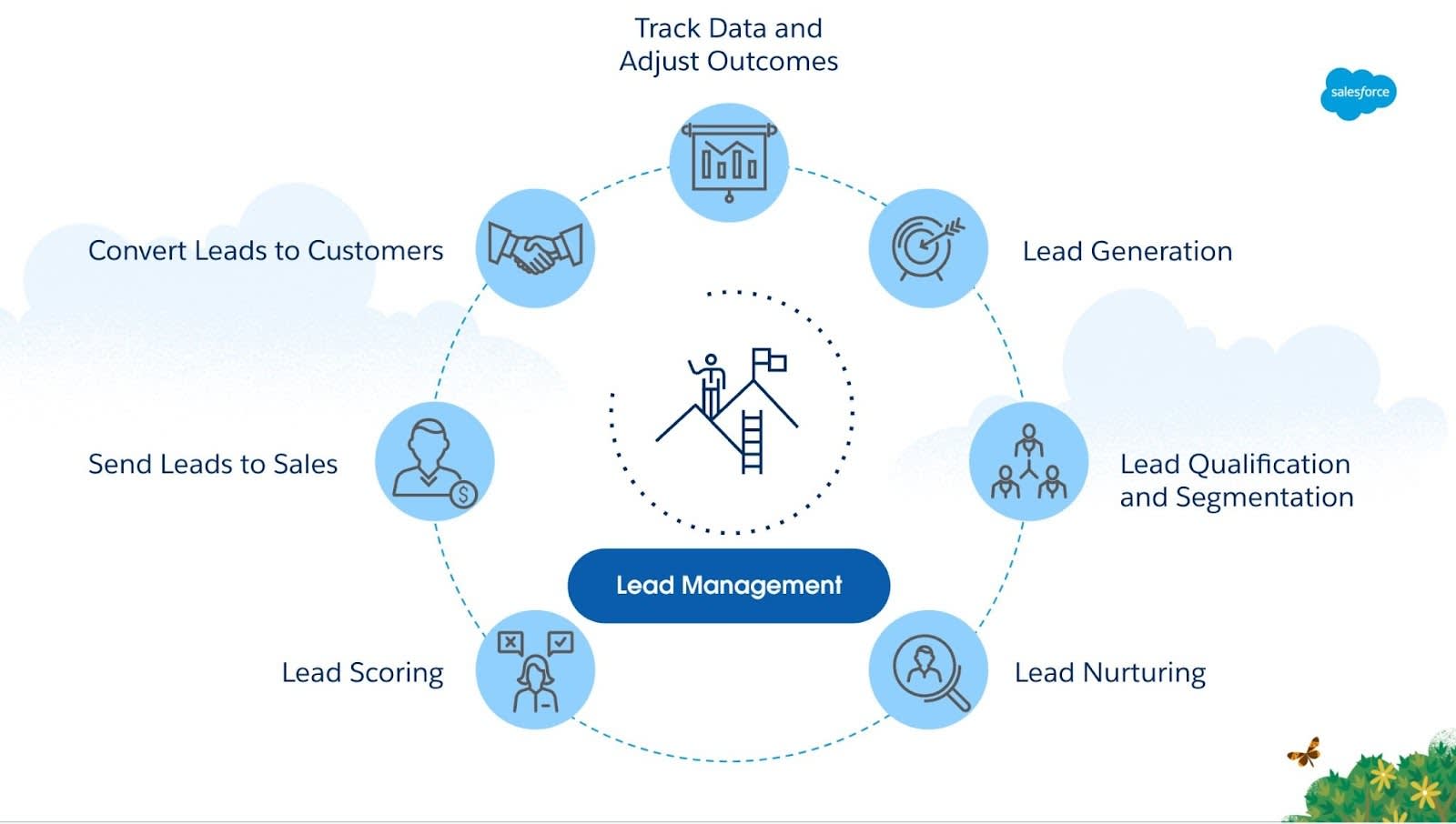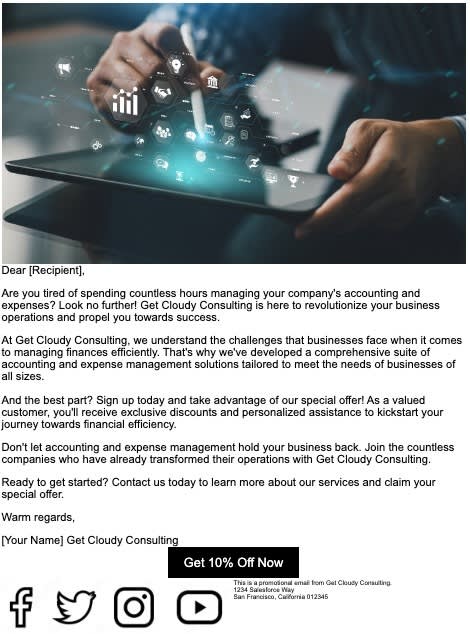Identify Marketing Assets
Learning Objectives
After completing this unit, you’ll be able to:
- Define lead management and marketing assets.
- Utilize best practices for identifying marketing assets.
Build Trusted Customer Relationships
Your marketing team has secured some solid leads that converted into customers. While this is exciting, a new challenge presents itself: developing a trusted relationship with your new customers. As you go through this lead generation and conversion process, how can you build trust, maintain a relationship, and potentially upsell while making the customer feel like you are only marketing to them? This is where lead management comes in.
Lead management refers to the ongoing processes involved in attracting leads, qualifying them, and converting them to customers. The lead management cycle starts with generating the leads and creating the first touchpoints with the prospect. Managing leads with Account Engagement is a critical part of a lead management strategy. It’s a holistic approach, using targeted marketing assets, focused on building trusted and meaningful relationships with your customers.
Leung Chan is the marketing manager at Get Cloudy Consulting, and her coworker Alan Johnson is the sales manager. Together they are developing a strategy to build and maintain strong customer relationships. They need to streamline their lead management process to efficiently handle potential clients, nurture them through the sales funnel, and convert them into paying customers. Let’s look at what they need to focus on when working through their strategy.

It’s important to remember that this process is iterative. You help your business most when you identify the source of your leads and then focus your marketing strategies to improve your return on investment. Ideally, you are building trust with your customers at the same time.
Reach Your Targeted Audience
Before moving on, let’s dig into the details of marketing assets and how they fit into your lead management strategy. Marketing assets are the resources and materials used by a business to promote its brand, products, and services. These assets cover various topics and are found in different channels, such as social media and landing pages. Marketing assets should be designed to reflect your brand identity and target audience. Your assets are working for you even when you aren’t. They promote your business, constantly drive awareness, and ultimately bring in revenue through sales.
There are many types of marketing assets available currently. You won’t need all these individual assets, only the ones that help you reach your target audience. Some examples include:
Online marketing examples include:
- Websites
- Blogs
- Whitepapers
- Social Media
- Email Campaigns
Print marketing examples include:
- Business Stationery
- Business Cards
- Signage
- Posters
- Print Ads
Personalize Your Marketing Assets
So how can Leung and Alan optimize their marketing assets to identify, nurture, and convert leads effectively? Let’s explore three strategies that can be utilized.
Build Your Brand
If your brand is your reputation, what is it saying about you? The market is crowded so how can your brand stand out? Creating a strong and unique brand can help differentiate your business. Investing in your brand by creating a strong, positive, and cohesive brand identity is key. It can help you attract new prospects and create a deeper connection with existing customers. Marketing assets that are built on this foundation help accurately represent your brand, connect to your target audience more effectively, and build a strong reputation in your industry.
Define Your Target Audience
Not all of the previous asset options will work for your business. It’s important to consider the ones that will best reach your target audience. To do that, you need to understand your target market. Who are they? What are they interested in? What tone or style will best resonate with them? As you learn more about them, you can tailor your content more. Like a dial on the radio, you can tune in to your target audience to increase the connection with your brand. This connection is the foundation of your relationship.
Communicate Your Message
Marketing assets need to communicate your message in a consistent, concise, and clear way. By having a well-designed brand identity that is cohesive across all channels, you will be able to communicate your messaging more effectively to your target audience. Create clear and concise communications without all the clutter. In today’s culture, it’s loud and noisy. Having a clear message doesn’t leave your customer guessing at what you are trying to say. By keeping your message simple, you can reach more people with your brand and produce better results.
Build a Clear Brand Identity
Leung and Alan did some work to identify their target audience and build marketing assets that they feel accurately communicate their message. Next, look at how they can use their marketing assets to build their brand.
When a prospect interacts with Get Cloudy Consulting through its marketing channels, such as the company website or a live webinar, the marketing team can evaluate that connection point to optimize for lead generation. As a best practice, evaluate the marketing channel often and make connections with prospects to keep them engaged and moving through the sales funnel. It’s considered best practice to respond within 24 hours if a prospect reaches out to you with a question. This helps keep the momentum as they are moving through the sales funnel.
As the prospect interacts with your company, that data is collected within Marketing Cloud Account Engagement. It’s a good idea to reach out early and often with a value-add proposition. This means Leung ensures her team provides a short, relevant statement that summarizes the benefits of her company’s goods or services. Usually, this includes timely information that provides an example of immediate value to the customer. Get Cloudy could send the following email to a small business owner who is not sure of Get Cloudy’s value with the headline: “Discover How Get Cloudy Streamlines Expense Reporting. Save 10% on the Suite” and the subheadline or paragraph, “Get Cloudy Consulting is the perfect consulting solution for any size business!”
 [alt text: Promotional Offer email as an example of a value-add proposition.]
[alt text: Promotional Offer email as an example of a value-add proposition.]
If you recall from the Lead Scoring and Grading in Account Engagement module, a prospect score is a numerical value to indicate how interested a prospect is in your product or service. A prospect grade assigns a letter grade to a prospect indicating how interested you are in them. It is the combination of the prospect’s score and grade that help determine the quality of the lead and provide useful input for the lead qualification strategy. This strategy determines how likely it is to sell to this prospect. This is where Account Engagement comes into play!
Use Account Engagement
Leung uses Account Engagement features to automate the lead qualification process. Once a prospect has reached a predetermined score and grade threshold, they are passed on to sales. At this point, Alan’s team takes over and ensures the prospect is automatically added to targeted email campaigns, webinars, whitepapers, and other content to keep them engaged and informed.
As prospects move through the sales funnel, each step includes personalized content and interactions with the sales team. Leung and her team are checking often to adjust and customize marketing assets and marketing channels to help identify, engage, and convert potential clients. Alan and his team are consistently nurturing leads and focused on increasing sales by creating strong relationships.
Using the tools and tips reviewed in this unit, Leung and Alan have set up a solid foundation for their lead management process. In the next unit, you dive deeper into using features of Account Engagement to create personalized marketing assets.